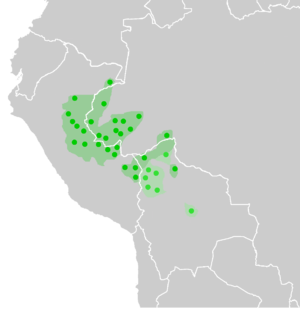Pano-Tacanan languages
Pano-Tacanan (also Pano-Takana, Pano-Takánan, Pano-Tacana, Páno-Takána) is a proposed family of languages spoken in Peru, western Brazil, Bolivia and northern Paraguay. There are two close-knit branches, Panoan and Tacanan (Adelaar & Muysken 2004; Kaufman 1990, 1994), with 33 languages. There are lexical and grammatical similarities between the two branches, but it has not yet been demonstrated that these are genetic (Loos 1999).
| Pano-Tacanan | |
|---|---|
| (proposed) | |
| Geographic distribution | southern Amazon |
| Linguistic classification | Macro-Panoan ?
|
| Subdivisions | |
| Glottolog | pano1259[1] |
 Panoan languages (dark green) and Tacanan languages (clear green). Circles indicate locations of modern languages. | |
Most Panoan languages are spoken in either Peru or western Brazil; a few are in Bolivia. All Tacanan languages are spoken in Bolivia (Ese’ejja is also spoken in Peru).
Genealogical relations
Migliazza has presented lexical evidence in support of a genetic relationship between the Panoan and Yanomaman languages. He also urges that a Panoan–Chibchan relationship is plausible.[2]
Jolkesky (2016) also notes that there are lexical similarities with the Arawakan languages due to contact.[3]
Bibliography
- Adelaar, Willem F. H.; & Muysken, Pieter C. (2004). The languages of the Andes. Cambridge language surveys. Cambridge University Press.
- Campbell, Lyle. (1997). American Indian languages: The historical linguistics of Native America. New York: Oxford University Press. ISBN 0-19-509427-1.
- Kaufman, Terrence. (1990). Language history in South America: What we know and how to know more. In D. L. Payne (Ed.), Amazonian linguistics: Studies in lowland South American languages (pp. 13–67). Austin: University of Texas Press. ISBN 0-292-70414-3.
- Kaufman, Terrence. (1994). "The native languages of South America." In C. Mosley & R. E. Asher (Eds.), Atlas of the world's languages (pp. 46–76). London: Routledge.
- Suárez, Jorge A. (1973). Macro-Pano-Tacanan. In International Journal of American Linguistics, Vol. 39, No. 3, pp. 137-154. The University of Chicago Press. Accessed from DiACL.
References
- Hammarström, Harald; Forkel, Robert; Haspelmath, Martin, eds. (2017). "Pano-Tacanan". Glottolog 3.0. Jena, Germany: Max Planck Institute for the Science of Human History.
- American Indian Languages, Oxford Studies in Anthropological Linguistics, Campbell, Lyle, 2000.
- Jolkesky, Marcelo Pinho de Valhery (2016). Estudo arqueo-ecolinguístico das terras tropicais sul-americanas (Ph.D. dissertation) (2 ed.). Brasília: University of Brasília.
External links
| Wiktionary has a list of reconstructed forms at Appendix:Proto-Pano-Takanan reconstructions |
- Proel: Familia Pano-Tacanana
- Proel: Familia Panoana
- Proel: Familia Tacanana